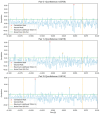Enhancing Maritime Domain Awareness Through AI-Enabled Acoustic Buoys for Real-Time Detection and Tracking of Fast-Moving Vessels
- PMID: 40293108
- PMCID: PMC11945802
- DOI: 10.3390/s25061930
Enhancing Maritime Domain Awareness Through AI-Enabled Acoustic Buoys for Real-Time Detection and Tracking of Fast-Moving Vessels
Abstract
Acoustic target recognition has always played a central role in marine sensing. Traditional signal processing techniques that have been used for target recognition have shown limitations in accuracy, particularly with commodity hardware. To address such limitations, we present the results of our experiments to assess the capabilities of AI-enabled acoustic buoys using OpenEar™, a commercial, off-the-shelf, software-defined hydrophone sensor, for detecting and tracking fast-moving vessels. We used a triangular sparse sensor network to investigate techniques necessary to estimate the detection, classification, localization, and tracking of boats transiting through the network. Emphasis was placed on evaluating the sensor's operational detection range and feasibility of onboard AI for cloud-based data fusion. Results indicated effectiveness for enhancing maritime domain awareness and gaining insight into illegal, unreported, and unregulated activities. Additionally, this study provides a framework for scaling autonomous sensor networks to support persistent maritime surveillance.
Keywords: OpenEar™; acoustic target recognition; artificial intelligence; localization; marine domain awareness (MDA).
Conflict of interest statement
Authors Robert McGurrin and Kimberly Gavin were employed by the company BlueIQ. The remaining authors declare that the research was conducted in the absence of any commercial or financial relationships that could be construed as a potential conflict of interest.
Figures











References
-
- Pollara A., Sutin A., Salloum H. Passive Acoustic Methods of Small Boat Detection, Tracking and Classification; Proceedings of the 2017 IEEE International Symposium on Technologies for Homeland Security (HST); Waltham, MA, USA. 25–26 April 2017; pp. 1–6.
-
- Kavitha R., Thayaambika M., Malini P.V., Almelu N. Passive Sensing and Detection of Boats along Coastline Using Static Sensors; Proceedings of the 2017 Third International Conference on Sensing, Signal Processing and Security (ICSSS); Chennai, India. 4–5 May 2017; pp. 474–479.
-
- Ng Y., Pereira J.M., Garagic D., Tarokh V. Robust Marine Buoy Placement for Ship Detection Using Dropout K-Means; Proceedings of the ICASSP 2020—2020 IEEE International Conference on Acoustics, Speech and Signal Processing (ICASSP); Barcelona, Spain. 4–8 May 2020; pp. 3757–3761.
-
- Lal S., Arora M.K., Riswandi B.A., Singh N., Singh B. AI Applications for Clean Energy and Sustainability. IGI Global; Hershey, PA, USA: 2024. Melding Artificial Intelligence and Remote Sensing Data for Real-Time Monitoring of Marine Biodiversity; pp. 299–319.
-
- Dogan G., Vaidya D., Bromhal M., Banday N. Chapter 14—Artificial Intelligence in Marine Biology. In: Hamadani A., Ganai N.A., Hamadani H., Bashir J., editors. Guide to Artificial Intelligence. Academic Press; Cambridge, MA, USA: 2024. pp. 241–254.
LinkOut - more resources
Full Text Sources

